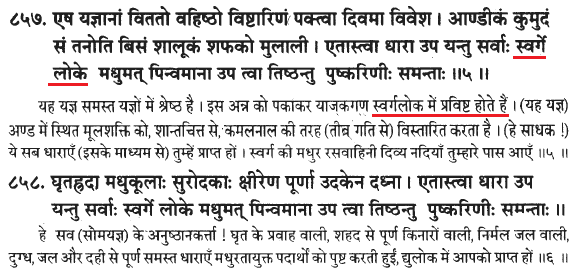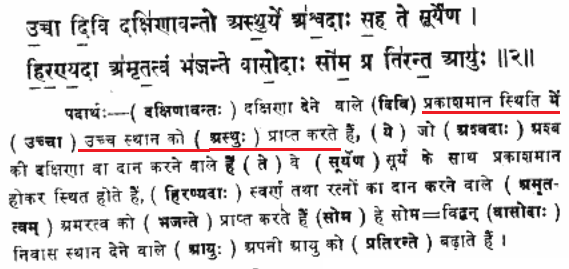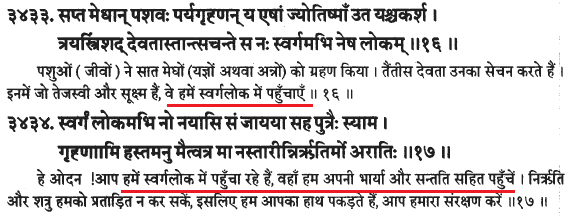Vedic Paradise: An Overview

Written by Ibn Muhammad
The concept of Paradise or a similar concept is found in almost all religious scriptures. Arya Samaj/agniveer rejects this reality, and hence we need to scrutinize it in detail. They claim that the difficulties and happiness of this worldly life are the NARK (Hell) and SWARG (Paradise) respectively. They claim that these are only states and not actual places. This claim is not only against the spiritual intuition of man, but also opposes the Vedas. Following exposition clearly proves this.
In the Vedas, Paraside is mentioned by the names स्वर्ग (Swarga), द्यो (dyo), नाक (Naaka),सुकृतस्य (Sukratasya), etc. These words have always been used in combination with the Sanskrit word लोके(loke) which means ‘a place’, ‘a region’, ‘a world’, all Locative cases. This proves that the word Swarga in the Vedas does not refer to any condition that affects an individual, but it is a distinct place.
Vedic Paradise is not on this earth
According to the Vedas Paradise is a place where only joy is found and misery is absent. This place is always mentioned by words which indicate that it is far from us; while as the present life is always mentioned by the words which indicate its nearness. If Swarga was only a state or feeling which one experiences in this world, it is illogical to speak of it as though it is found elsewhere. For example see the following mantras:
7 O Pavarnana, place me in that deathless, undecaying world, wherein the light of heaven is set, and everlasting lustre shines. Flow, Indu, flow for Indra’s sake.
8 Make me immortal in that realm where dwells the King, Vivasvat’s Son, where is the secret shrine of heaven, where are those waters young and fresh. Flow, Indu, flow for Indra’s sake.
9 Make me immortal in that realm where they move even as they list, in the third sphere of inmost heaven where lucid worlds are full of light. Flow, Indu, flow for Indra’s sake.
10 Make me immortal in that realm of eager wish and strong desire, the region of the radiant Moon, where food and full delight are found. Flow, Indu, flow for Indra’s sake:
11 Make me immortal in that realm where happiness and transports, where Joys and felicities combine, and longing wishes are fulfilled. Flow, Indu, flow for Indra’s sake.
( Rig Veda – Mandal 9; Sookt 113, Mantras 7-11)

These references amply prove that Paradise is not in this world but it is a distinct place which we can only inherit after death. The mantras quoted above show that
1) There is no death in Paradise
2) It is eternal
3) It is resplendent with eternal light
4) That world is under King Vivasvat’s Son i.e. Yama
5) It has fresh water
6) It is the third region
7) Food is abundant there
8) It is the place of the Sun
9) It is a place where all desires are fulfilled
Where is this Paradise?
Having established that Vedic Paradise is not on this earth but is a distinct world altogether, we will now see where that Paradise is located. In several Vedic mantras, Paradise has been identified as the third region, the other 2 being the earth and space. Thus it is written in Rig Ved

“In the third region which distils a thousand streams, may the Exhaustless Ones descend with procreant power.” [Rig Veda – Mandal 9; Sookt 74; Mantra 6]

“Whether, O Indra and Agni, you be dwelling in highest Paradise, in central region, or on earth, come hither, from wherever you may be and drink libations of the flowing Soma.” [Rig Veda- Mandal 1; Sookt 108; Mantra 10]

“In the third heaven above us stands the Asvattha tree, the seat of gods. There the gods sought the Kushtha Plant, embodiment of endless life.” [Atharva Ved Kaand 5; Sookt 4; Mantra 3]

“May we be free in this world and that yonder, in the third world may we be unindebted. May we, debt-free, abide in all the pathways, in all the worlds which Gods and Fathers visit.” [Atharva Ved Kaand 6; Sookt 117; Mantra 3]

“Dwelling with zeal I mount in spirit after the lofty sacrifice as it departs. Agni may we, beyond decay, invited, in the third heaven, feast and enjoy the banquet.” [Atharva Ved Kaand 6; Sookt 122; Mantra 4]

“From the back of the earth, I have ascended to the mid space. From the mid space, I have ascended to the heaven. From the top of the heaven, the sorrow less world, I have reached the world of light.”[Atharva Veda Kand 4; Sookt 14; Mantra 3]
It is evident from all the above references that the Paradise promised in the Vedas is neither a condition nor or this earth. Rather, it is the third region above the earth and space, according to the sequence given in these mantras. Vedas speak of this Paradise being the third region in numerous other mantras, but I only gave few samples. These mantras also prove that real joy and happiness is found only there.
How far is the Vedic Paradise?
Most religions which speak of Paradise do not raise this question nor are required to answer it. It seems that Vedic Dharm is perhaps the only religion which addresses this question uniquely. Thus it is said,

“This gold-hued Hansa’s wings, soaring to heaven, spread over a thousand days’ continued journey, supporting all the Gods upon his bosom; he goes his way beholding every creature.” [Atharva Ved Kaand 13; Sookt 2; Mantra 38]
It is mentioned in Aitareya Brahman,
![]()
“For the heavenly world is at a distance of about thousand days’ travelling on a horseback (ashveen)” [Aitareya Brahman- Panicka 2: Paragraph 17; words in braces mine]
The ancient Indian Sanskrit Grammarian, Panini writes
“One ashveen is the distance travelled over or traversed by a horse in one day” [Ashtadhyayi- Book 5; Chapter 2; Sootra 19]
From these mantras we come to know that according to the Vedas the distance travelled by a horse in thousand days is the distance of Vedic Swarg from this earth. In other words, the distance of Vedic Paradise from the earth is about hundred thousand miles!!
Who inherits Vedic Paradise and How?
So far the previous mantras also imply that Vedic Paradise is not a Karma Jeevan (world for performing deeds) but a Bhog Jeevan(reaping the fruits of one’s deeds). To know more about this, it is good enough to take a look at more Vedic Mantras.
Atharva Veda says,

“Joy have you found, and left ill-will behind you: you have attained the happy world of virtue.” [Atharva Ved Kaand 2; Sookt 10; Mantra 7]

“May we, fame-seekers, reach the world of virtue by service of the Gharma and through fervour, whereby the Gods went up to heaven, the centre of life eternal, having left the body.” [Atharva Ved 4:11:6]

“With milk and butter I anoint the mighty, celestial Goat, strong-winged, and full of juices. Through him will we attain the world of virtue, ascending to the loftiest cope, to heaven.” [Atharva Ved 4:14:6]

“Strongest is this, performed, of sacrifices: he has reached heaven who has prepared Vishtāri. [Atharva Ved 4:34:5]

“High up in heaven abide the Guerdon-givers: they who give steeds dwell with the Sun forever. They who give gold are blest with life eternal. They who give robes prolong their lives, O Soma.” [Rig Veda – 10:107:2]

“The Goat Panchaudana, when cooked, transports, repelling Nirriti, to the world of Svarga. By him may we win worlds which Sūrya brightens.” [Atharva Ved 9:5:18]

“…This wealth I place among the Brāhmans, making a path that leads to heaven among the Fathers.” [Atharva Ved 11:1:28]
To sum up, according to most mantras in Atharva Ved, feeding the Brahmins with milk and rice (Kheer), offering goats, gold, and otherDakshina earns one Paradise. Displeasing a Brahmin gives you a one way ticket to Hell. In the Rigveda, often we find ways to earn Paradise by praying to the gods and as per Yajurveda Paradise is earned by animal sacrifice.
Of course, good deeds are also said to earn one Paradise as per the Vedas and other scriptures. Bad deeds earn one a place in Hell. The Judgement in the life hereafter based on the weight of good and bad deeds is mentioned in Shatpath Brahman as follows:
“Now, as to that balance, the right (south) edge of the Vedi. Whatever good deed man does that is inside the Vedi; and whatever evil deed he does that is outside the Vedi. Let him therefore sit down, touching the right edge of the Vedi; for, indeed, they place him on the balance in yonder world; and whichever of the two will rise, that he will follow, whether it be the good or the evil. And, verily, whosoever knows this, mounts the balance even in this world, and escapes being placed on the balance in yonder world; for his good deed rises, and not his evil deed.” [Shatpath Brahman- Kaand 11; Adhyay 2; Brahman 7; Kaandika 33]
In common Hindu parlance it is called Dharm Tula and in Islamic terminology as Meezanul Amaal.
Is Vedic Paradise physical or spiritual?
After presenting so many references regarding the world of Swarga, it was not necessary to again bring up this topic, because all the previous mantras abundantly prove that Vedic Paradise is not spiritual but a physical dwelling. However, the following mantras throw more light on Vedic Paradise:

“If Agni Jātavedas, as he bore you hence to the Fathers’ world, had left one single limb of your bodies, here do I restore it. Fathers, rejoice in heaven with all your members!” [Atharva Veda- Kaand18; Sookt 4; Mantra 64]

“…The three-and-thirty Deities attend them. As such, conduct us to the world of Svarga. Unto the world of Svarga shalt thou lead us: there may we dwell beside our wife and children…” [Atharva Ved 12:3:16,17]

“There where our virtuous friends, who left behind them their bodily infirmities, are happy, free from distortion of the limbs and lameness, may we behold, in heaven, our sons and parents.” [Atharva Ved 6:120:3]
All these mantras convincingly prove that Vedic Paradise is physical and material, where people will get material blessings. In my next article, Vedic Paradise: The Inside Story, we will take a look at the inner scene of the Vedic Paradise. All the mantras that I have produced till now, refute the strange, anti-Vedic view of Arya Samaj/agniveer.

